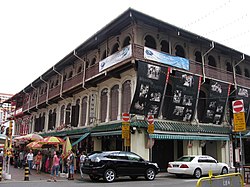
Traditional Chinese opera, or Xiqu, is a form of musical theatre in China with roots going back to the early periods in China. It is an amalgamation of various art forms that existed in ancient China, and evolved gradually over more than a thousand years, reaching its mature form in the 13th century, during the Song dynasty (960–1279). Early forms of Chinese theater are simple, but over time various art forms such as music, song and dance, martial arts, acrobatics, costume and make-up art, as well as literary art forms were incorporated to form traditional Chinese opera. Performers had to practice for many years to gain an understanding of the roles. Exaggerated features and colors made it easier for the audience to identify the roles portrayed.

Chinatown is a subzone and ethnic enclave located within the Outram district in the Central Area of Singapore. Featuring distinctly Chinese cultural elements, Chinatown has had a historically concentrated ethnic Chinese population.
Tiong Bahru is a housing estate located within the Bukit Merah Planning Area, in the Central Region of Singapore. Tiong Bahru was constructed in the 1920s by the Singapore Improvement Trust, the predecessor to the Housing Development Board and an entity of the British colonial authority providing mass public housing in Singapore and is the oldest housing estate in Singapore. The main estate consists of 30 apartment blocks with over 900 units of two to five rooms that are also commonly referred to as "walk-ups". There are also high-rise Housing and Development Board (HDB) flats and condominiums along Boon Tiong Road, Jalan Membina and Kim Tian Road which surround the main estate.

Hong Lim Park, formerly known as Hong Lim Green and Dunman's Green, is a 0.94-hectare (2.3-acre) heritage park in the Downtown Core district of Singapore located next to the Parkroyal Collection Pickering hotel and Clarke Quay station.

Lui Seng Chun is a Grade I Historic Building located at 119 Lai Chi Kok Road, in Mong Kok, Hong Kong, at the junction with Tong Mi Road. It is a four-storey tong-lau that was built in 1931 by Mr. Lui Leung. The architect was Mr. W. H. Bourne.

Pagoda Street is a street located in Chinatown within the Outram Planning Area in Singapore. The road links New Bridge Road and South Bridge Road, but has since been converted to a pedestrian mall to Chinatown MRT station at its New Bridge Road end.

Temple Street is a one-way street in Chinatown within the Outram Planning Area in Singapore. The road links South Bridge Road to New Bridge Road, and is intersected by Trengganu Street.

Sago Lane is a one-way lane in Chinatown within the Outram Planning Area in Singapore. The street links Banda Street to Neil Road. In the past, the street was much longer and was home to funeral parlours or death houses. Part of the street was demolished in the late 1960s due to the construction of the new HDB development at Kreta Ayer, also known as Chinatown Complex. Currently the street, is mainly used during Chinese New Year as part of the festive bazaar in Chinatown.

Balestier is a sub zone located in the planning area of Novena in the Central Region of Singapore. The main road, Balestier Road, links Thomson Road to Serangoon Road and the road continues on as Lavender Street. The area is home to rows of shophouses, such as the Sim Kwong Ho shophouses, the Balestier Art Deco shophouses, 412-418 Balestier Road, and 601-639 Balestier Road, low-rise apartments and commercial buildings as well as a shopping mall known as Shaw Plaza. Balestier also has another mall, Zhongshan Mall. There are several lighting and electrical shops along Balestier Road, which is also home to the Ceylon Sports Club and the Indian Association. The area is known for its food such as bak kut teh and chicken rice. In the area, there are several apartments, condominiums, and budget hotels.

The Majestic is a historic building on Eu Tong Sen Street in Chinatown, Singapore next to Chinatown MRT station. Located between the People's Park Complex and Yue Hwa Building, it was known as Majestic Theatre, which was a Cantonese opera house.

Yue Hwa Building is a historic building located at the junction of Eu Tong Sen Street and Upper Cross Street in Chinatown, Singapore, next to Chinatown MRT station. Built by Swan and Maclaren in 1927, it was then the tallest building in Chinatown and was known as Nam Tin Building (南天大厦), owned by Lum Chang Holdings. The building housed the six-storey Great Southern Hotel, along with a few shops and cabarets that were popular among Chinese travellers. In 1993, Lum Chang Holdings sold the building to Hong Kong businessman Yu Kwok Chun, who converted it to the first Yue Hwa Chinese Products department store in Singapore in 1994. The renovation process, which conserved the exterior while adding features such as an atrium and waterfall to the interior, won the building the Architectural Heritage Award by the Urban Redevelopment Authority in 1997.

Kim Seng Road is a street in Singapore that runs along the upper-easternmost portion of the Bukit Merah-Central Area border. It was named after Peranakan philanthropist, Tan Kim Seng. Today, the boundaries of Kim Seng division are: Indus Road and Alexandra Canal in the north; Jalan Bukit Ho Swee in the south; Kim Seng Road and Outram Road in the east; and Lower Delta Road in the west.
This is a list of public housing estates (including Private Sector Participation Scheme, Home Ownership Scheme and Tenants' Purchase Scheme in Tin Shui Wai New Town, Hong Kong.

Chinatown is located at Padungan road, Kuching, Sarawak, Malaysia. The most notable streets in the Chinatown are Main Bazaar and Carpenter Street.

Siong Leng Musical Association or Siong Leng is a Nanyin musical group from Singapore. Siong Leng is known for its contribution to preserve and promote Nanyin and Liyuan Opera, the arts of Southern Min people.

Capella Singapore is a luxury resort hotel situated in 30 acres (12 ha) of grounds and gardens located on Sentosa Island, Singapore. It has 112 manors, suites and guestrooms designed by Norman Foster. It was developed by Pontiac Land and officially opened in March 2009. Capella Singapore's long-stay accommodation arm, The Club at Capella Singapore comprises 81 serviced apartments, penthouses and manors.

Winter Begonia is a 2020 Chinese television series starring Huang Xiaoming, Yin Zheng, and Charmaine Sheh, based on Shui Ru Tian Er's BL web novel of the same name. It aired exclusively on iQiyi and tells the story of the close relationship between a shrewd businessman and a Peking opera genius right before the World War II. While the original web novel depicted the relationship between the two main men as romantic, the adaptation changed this depiction into a "bromance".
Titoudao is a play by Singaporean playwright Goh Boon Teck. It was first staged in Singapore at the Jubilee Hall Raffles Hotel by theatre company, Toy Factory Productions, in 1994. The play was restaged again in 2000, 2007 and 2015. In 2020, the play was adapted into a TV series on Mediacorp’s Channel 5 and Channel 8.





















